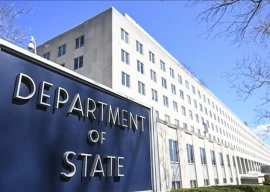
It is the 20th of November. If you look out the window you may notice that heavens have not fallen nor hell frozen over. Today marks Faiz Ahmad Faiz’s 37th death anniversary. While he is gone his work, name, and legacy live on. But pundits seldom have time to pay homage to legendary poets.
On the 18th of this month, Tahreek e Labbaik Pakistan’s young leader Saad Rizvi was released from the government’s custody. Many of us have previously vented about the ease with which now-not-so-proscribed TLP extracts concessions from the state every time it marches on Islamabad. But in view of fierce debates about its origin, I feel that many unanswered questions deserve to be asked.
To many of you, the Faizabad sit-in is decidedly the first introduction to the TLP and its founder Khadim Rizvi. It was the moment when many first came to recognise its street power, particularly once the police had unsuccessfully attempted to uproot the sit-in. A two-bench Supreme Court bench comprising Justice Qazi Faez Isa and Justice Musheer Alam took a sua sponte notice of the incident and later released a detailed verdict. Given that the verdict was lauded by the moderate and liberal factions of the civil society it is difficult to point out three critical flaws in this document. For instance, the bench does not dwell on how the TLP procession traveled from Lahore to Faizabad without facing any impediments or police resistance. It also does not question the choice of Faizabad as the venue of the sit-in through the administrative lens. And then it seeks the financial data from the ISI which should have been sought from the FBR and the State Bank of Pakistan. When the agency’s representative submitted this, the bench spent a lot of time examining the mandate of the agency instead. Did it seek the given data from the concerned departments mentioned above eventually? We are not told.
A lot of this owes itself to the perception that the ISI had a hand behind the sit-in. But the three shortcomings mentioned above are critical to understanding the phenomenon itself. The travel area covered by the protesters between Lahore and Islamabad falls under the jurisdiction of the Punjab government’s home ministry. The administrative significance of Faizabad is that it is the first interchange beyond the jurisdiction of Rawalpindi, a city part of Punjab. The sources of the TLP funding are important because at the time of the dispersal of the protesters the state of Pakistan had to offer them nominal travel expenses. This crowd left Lahore and traveled to Islamabad without being accosted by the Punjab police and staged its sit-in right outside its jurisdiction and without a significant amount of money traceable through banking transactions.
Let me remind the readers that the PML-N was in power in Punjab and formed the government at the Centre again despite being weakened by the Panama Papers’ judgment. These days we interpret all of this in the light of the alleged differences between the houses of Nawaz and Shahbaz. But this late realisation deflects attention from a myriad of nuances and a rather remarkable cast of characters. The home minister of the province at the time was Rana Sanaullah. He had returned to this office after being removed to investigate his alleged role in the Model Town shootout. He was brought back to the position after his immediate predecessor Shuja Khanzada was assassinated by terrorists.
Now, there is a persistent habit to view Rana as an inextricable part of Shahbaz Sharif’s posse. But the days following the disqualification of Nawaz Sharif showed how he is his own man. When Shahbaz Sharif was nominated to succeed Nawaz and Shahid Khaqan Abbasi after getting elected to the National Assembly, Rana stayed quiet. Sources close to him claimed that he expected to be nominated the next chief minister of Punjab. However, when it became clear that consensus had emerged in support of Hamza Sharif he issued a statement. Shahbaz should not leave Punjab so close to the election. And Shahbaz decided not to go. Just like that.
But the story of the TLP did not start or end with the Faizabad sit-in. You first notice the TLP’s founder at the mammoth funeral ceremony of Mumtaz Qadri and the protests that followed his hanging. Policeman Mumtaz Qadri was hanged for murdering Governor Salman Taseer while he was on duty to protect him. Taseer was accused of blasphemy for meeting Aasia Bibi, an incarcerated Christian woman accused of blasphemy, and supporting her acquittal. That much you remember. And what about things before that?
Taseer, a businessman, media owner, and PPP stalwart, became an immediate target of hate when he was included in General Musharraf’s caretaker cabinet as commerce minister. After being appointed he went out of the way to support Musharraf. This was the heyday of the lawyers’ movement. On May 15, 2008, Musharraf appointed him as governor of the Punjab province. Yousuf Raza Gilani, the then PM, maintains that instead of consulting him the former president only informed him of this decision during a phone call.
The PML-N’s animus against the man hit a crescendo when after Musharraf’s departure President Zardari decided to retain him as the governor and following a court decision disqualifying Sharif brothers, governor’s rule was imposed in Punjab. This led to a long march with Nawaz Sharif and Aitzaz Ahsan in the lead culminating in the reinstatement of the judges deposed under the PCO and eventually to the end of the governor’s rule and restoration of the PML-N government in Punjab. In the meantime, a segment of the mainstream media continued a campaign against Taseer. When a police officer and a student walked out on the governor during two ceremonies it was the main lead in the news bulletins. Even after the end of the governor’s rule, the animus did not go away. So much so that on the day of Taseer’s death a significant portion of ‘Qadri tujhay salam’ text messages that reached this scribe was from the PML-N supporters. Many of their leaders still call him a hero.
There are unanswered questions regarding this episode. Find their answers and you may find out how the TLP came into being. Was Qadri a part of Taseer’s regular detail? If not who decided to bring him in? Were his views on the governor well-known and if not why was he not vetted? Who recommended the Aasia Bibi meeting to Taseer? Why did late Justice (retd) Khawaja Sharif, a judge accused of being allied to the PML-N, decide to be Qadri’s defence counsel? Why do all controversies take you to Faisalabad’s Ghantaghar?
We don’t know about this because our pundits filter out crucial details. No one goes out of the way looking for answers to difficult questions. Recently, when the TLP was marching again a day before the recent deal, a high-powered media briefing took place. I can tell you with confidence that at no point was a negotiated settlement ruled out as an option. But our pundit friends only shared the whispers of an impending clampdown. ‘Jaw jaw’ was reported, ‘talk talk’ omitted. And then they mistake mitigation for collusion.
Published in The Express Tribune, November 20th, 2021.
Like Opinion & Editorial on Facebook, follow @ETOpEd on Twitter to receive all updates on all our daily pieces.





1726222798-0/Tribune-Pic-(13)1726222798-0-165x106.webp)














COMMENTS
Comments are moderated and generally will be posted if they are on-topic and not abusive.
For more information, please see our Comments FAQ